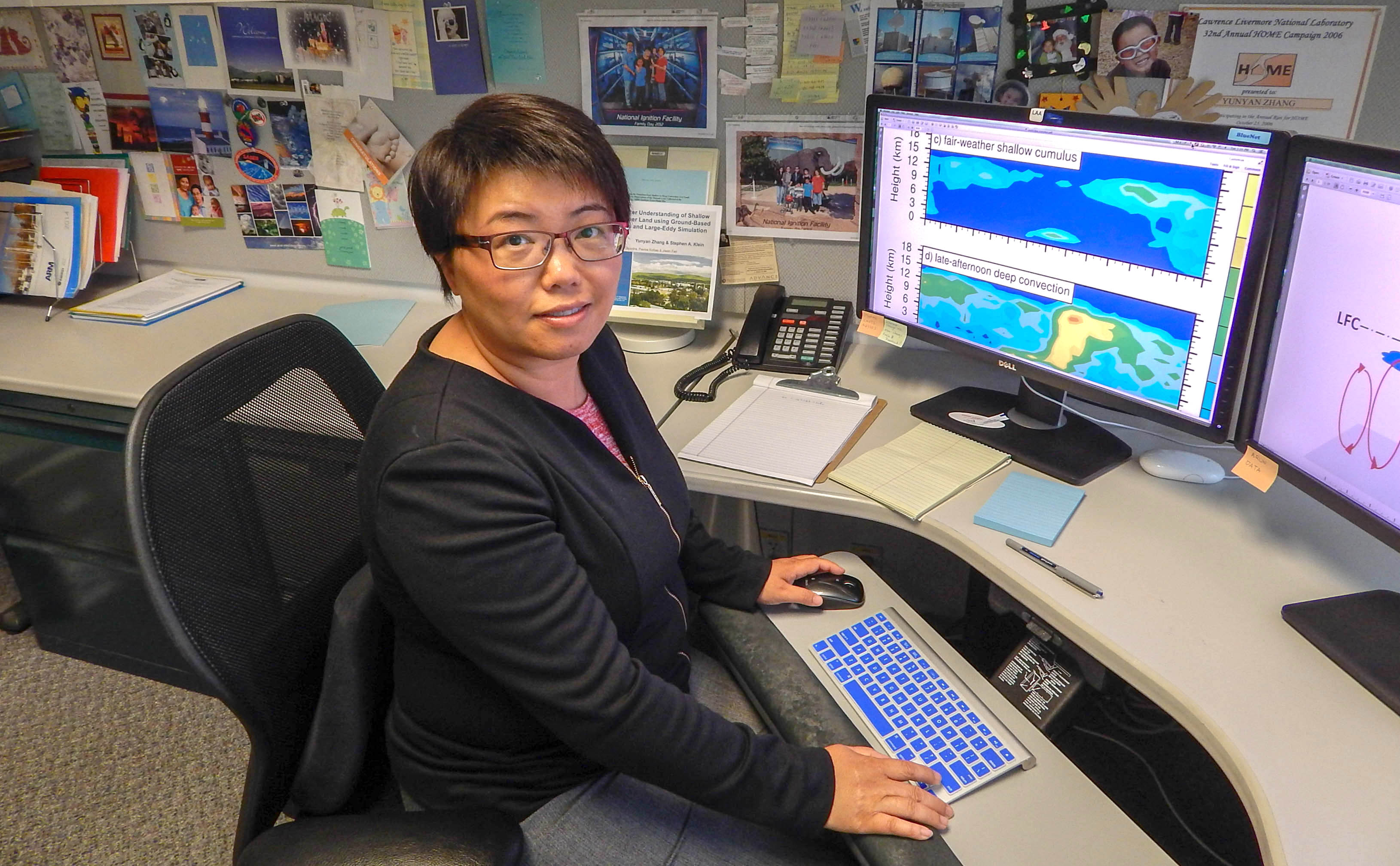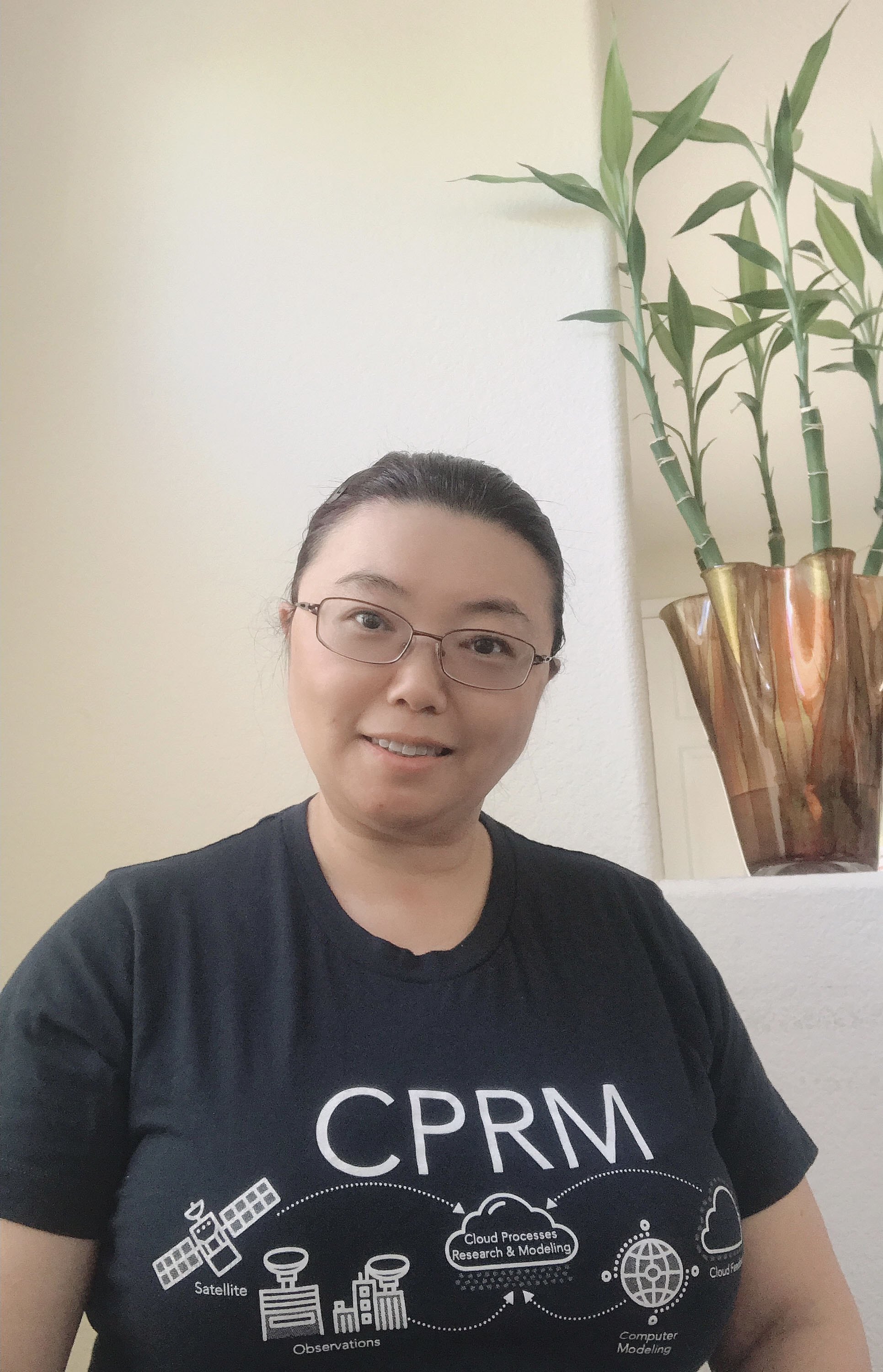UEC Profile: Modeling Boundary-Layer Clouds
Published: 19 April 2021
A California researcher leverages ARM data and ASR funding to boost understanding of land-atmosphere-cloud interactions
Editor’s note: This is the second article in a new series of profiles on members of the ARM User Executive Committee (UEC).

Yunyan Zhang, a staff scientist at Lawrence Livermore National Laboratory in California, models the life cycles of clouds. Scientists rely on observations and numerical simulations to understand these suspended masses of water and ice in the atmosphere.
At Livermore, Zhang is a member of the Cloud Processes Research and Modeling group, a series of words that neatly sums up her interests.
Zhang is working on research funded by the U.S. Department of Energy’s (DOE) Atmospheric System Research (ASR).
She is also one of the newest members of the DOE Atmospheric Radiation Measurement (ARM) user facility’s User Executive Committee (UEC).
By design, UEC members represent a range of disciplines―all the better to convey the needs of users to ARM management.
Within the world of modeled cloud life cycles, Zhang also has a strong interest in how clouds interact with the Earth’s surface and the atmospheric boundary layer right above it. The boundary layer’s height varies from about 100 meters (328 feet) to 3,000 meters (9,800 feet).
The Earth’s troposphere extends about 11 kilometers (36,100 feet) upward, but only the boundary layer―where clouds, air, and most atmospheric gases exist―is directly influenced by surface conditions.
Land-Atmosphere Experts
“Land surface properties and their heterogeneities affect the evolution of the atmospheric boundary layer, convection initiation, and moisture budget at multiple temporal and spatial scales.”
Yunyan Zhang, the ARM User Executive Committee’s land-atmosphere interactions representative
Zhang’s studies of land-atmosphere interactions in this shallow layer of air must incorporate the complexities of weather, winds, and diverse land surface covers and conditions. Zhang is also a student of the atmospheric diurnal cycle, which causes daytime-nighttime temperature variations near the Earth’s surface.
Understanding and modeling coupled land-atmosphere interactions is critical for predicting both regional weather and the state of earth systems.
“Land surface properties and their heterogeneities affect the evolution of the atmospheric boundary layer, convection initiation, and moisture budget at multiple temporal and spatial scales,” says Zhang. “The mechanistic understanding of these interactive processes and feedbacks between land and atmosphere is crucial to a better representation in climate models.”
After taking on her new role as the UEC’s land-atmosphere interactions representative, Zhang was invited to be an organizer of a June 10–11, 2021, virtual workshop on such interactions. Open to researchers worldwide, the workshop launches a “Year of Water Fluxes” theme sponsored by DOE’s AmeriFlux network and is in collaboration with community representatives from ARM and ASR.
An Ideal Outdoor Laboratory

There are large discrepancies in the ways regional and global earth system models represent how clouds and precipitation are influenced by surface conditions, especially over land. In such models, boundary-layer clouds (which may live as little as an hour) pose a particularly stubborn representational problem.
Zhang hopes to change that by reducing uncertainties in today’s models. Broadly, her strategy is to combine decades of ARM observations with cloud-scale models to gain new understanding of detailed land-atmosphere interactions.
To illustrate the latest work in her years of research, Zhang co-authored a February 2021 paper on modeled land-atmosphere coupling in the U.S. Great Plains. The data came from nine years of continuous warm-season measurements at ARM’s Southern Great Plains (SGP) atmospheric observatory, spanning parts of Oklahoma and Kansas.
She calls the SGP an ideal laboratory for her work. Spread out over 55,000 square miles, the SGP has diverse ground cover and numerous devices for measuring land properties and profiling the atmospheric boundary layer and clouds.
In the 2021 paper, Zhang acknowledged ARM data, as well as funding from ASR and her five-year DOE Early Career Research Program award.
Ongoing Work

The 2021 study took advantage of the SGP’s long-term, comprehensive observations. It also bridged observations and earth system models with advanced process diagnostics. All that helped researchers assess model performance in representing land-atmosphere coupling during three local convective regimes: clear-sky days; fair-weather, shallow-cumulus days; and afternoon deep-convection days.
With a few papers just wrapping up, and a postdoctoral researcher still at work, says Zhang, the project is still active but will phase out soon.
“We continue to study the land-coverage effect on shallow cumulus initiation,” she says. “We’re using data from ARM’s extended networks at SGP―in grassland and forest―combined with satellite data that can cover a vast area of SGP.”
Mathematical simulations of land-atmosphere interactions have been a steady theme in Zhang’s career going back to her undergraduate days at what was then Peking University in Beijing, China (B.S., 1998).
After that, during her doctoral studies at the University of California, Los Angeles (PhD, 2006), Zhang shifted her focus to clouds without letting go of her interest in land surfaces.
Since 2017, she has co-chaired the ASR Warm Boundary Layer Processes Working Group. With colleagues in the group, she works intensively on understanding continental shallow cumulus clouds, their transition to deep convection, and their interactions with land surfaces.
Large-Eddy Simulations
In most studies of the atmospheric boundary layer, two types of clouds predominate: fair-weather, shallow cumulus clouds and stratocumulus clouds.
Shallow cumulus clouds are closely tied to thermal air columns, which are triggered by mechanisms at the Earth’s surface, including changes in temperature.
Stratocumulus clouds dwell in the humid upper reaches of the boundary layer, where cooler temperatures allow water vapor to condense.
In 2017, Zhang led a paper about large-eddy simulations of shallow cumulus clouds over land, and once again relied on long-term SGP observations. Models often visualize turbulence in terms of eddies, which are swirls of air motion so irregular and eccentric that they must be modeled mathematically at finer scales, such as in large-eddy simulations.
In turn, long-term network observations, such as those from the SGP, keep such simulations “constrained”—that is, within realistic bounds.
In the paper, Zhang and her co-authors developed a new case study to represent shallow cumulus convection over land. Importantly, the influences of local temperature and humidity are reflected more accurately than before in the new case, which could supplant an often-used “golden day” ARM case from 1997. Modelers can use it to take advantage of upgraded ARM instrumentation and data since 1997, including enhanced measurements of surface heat fluxes.
SGP observations were also at play in a 2018 paper Zhang co-authored on boundary-layer controls on clouds that are related to updraft properties derived from Doppler lidar.
Leading that study was cloud-updraft expert and ASR researcher Neil Lareau, now at the University of Nevada, Reno, who says his work, in a nutshell, is about “how hot air rises.” As a postdoc at Livermore, he worked with Zhang on understanding the surface and atmospheric conditions that control the formation of shallow clouds. His 2017–2020 ASR project investigated how boundary-layer updrafts influence shallow-to-deep cloud transition.
Surface Heterogeneity

Zhang and Livermore colleagues Stephen A. Klein and Jungmin M. Lee revisited the effect of wind and surface heterogeneity on cumulus clouds in a 2019 paper led by Lee. Once again, SGP data were prominent as a way of capturing heterogeneous land characteristics.
Prominent, too, were large-eddy simulations, key modeling constants in Zhang’s work. She uses such simulations to capture turbulence at a very fine resolution, on the order of data cubes only 20 meters by 20 meters (about 66 feet by 66 feet).
In that way, says Zhang, earth system models can be informed by “how turbulence will transfer heat and moisture” and the effect on clouds and precipitation.
The operative phenomenon in the 2019 paper is that heterogeneous land characteristics prompt different heating of the atmosphere, stirring a secondary circulation regime that influences the boundary layer.
But it was another paper, also in 2019, that went directly to the soil moisture work Zhang did as part of her DOE Early Career award.
Led by Livermore’s Cheng Tao, the study leverages a decade of SGP data to look at land-atmosphere coupling and localized moisture budgets during the May-to-August warm season. The researchers accounted for grassland, pasture, and forest cover to examine how the land surface controls the evolution of the boundary layer and how that influences cloud and precipitation development.
‘Nothing Has Ended’
“It is crucial for us to understand how land surface conditions may affect boundary-layer evolutions and secondary circulations, cloud formations, and afternoon convection, and how these fast physical processes feed back to long-term climate.”
Zhang
Land-atmosphere coupling processes are important “at multiple temporal and spatial scales that interact with each other,” says Zhang.
In models, she and others are dealing with “strong warm and dry biases that still prevail in summertime climate simulations over land regions, such as the central United States,” adds Zhang. “It is crucial for us to understand how land surface conditions may affect boundary-layer evolutions and secondary circulations, cloud formations, and afternoon convection, and how these fast physical processes feed back to long-term climate.”
Coupling long-term SGP data with large-eddy simulations and the power of Livermore’s modeling group, says Zhang, brings a greater understanding of land-atmosphere interactions closer than ever.
Meanwhile, her cloud work is ongoing―though it is moving toward using ARM’s advanced data to improve DOE’s Energy Exascale Earth System Model (E3SM).
“This is a continuous story for me,” says Zhang of her present work. “It makes a good ending to say that nothing has ended.”
Keep up with the Atmospheric Observer
Updates on ARM news, events, and opportunities delivered to your inbox
ARM User Profile
ARM welcomes users from all institutions and nations. A free ARM user account is needed to access ARM data.


















